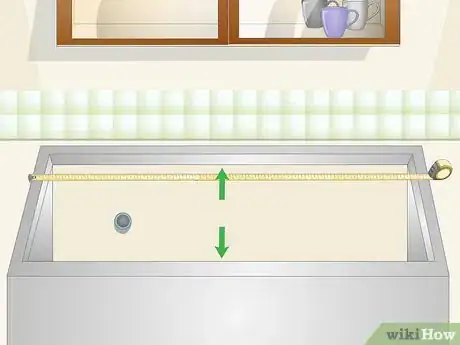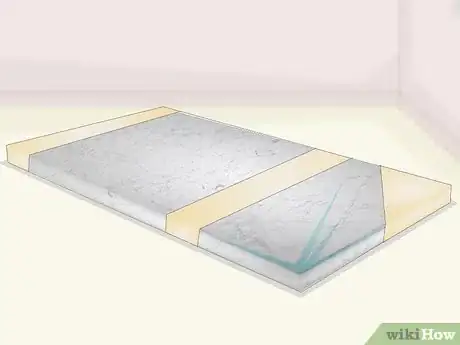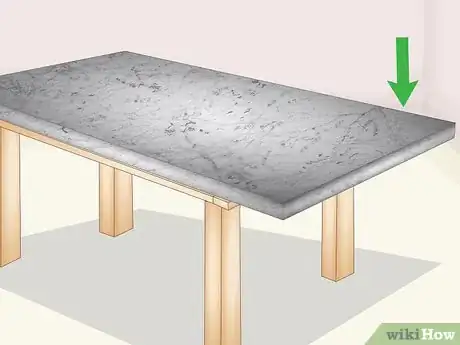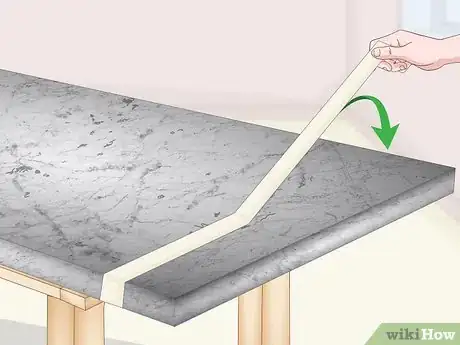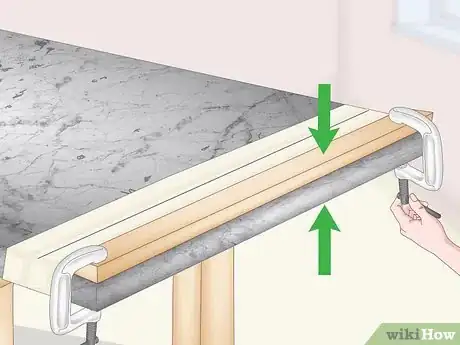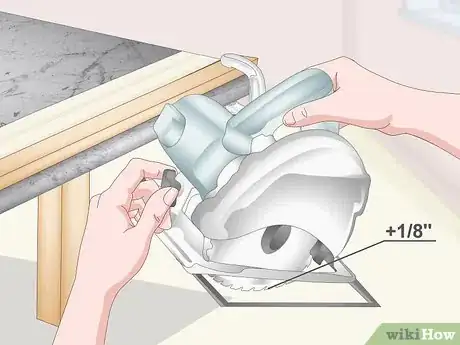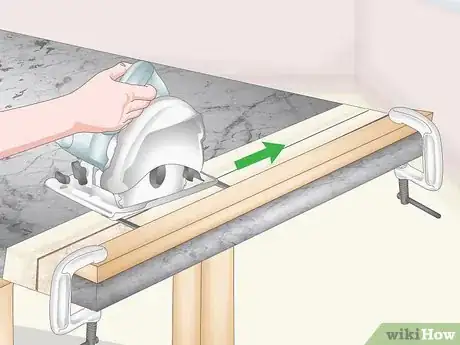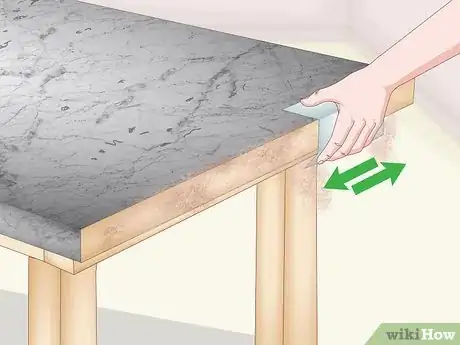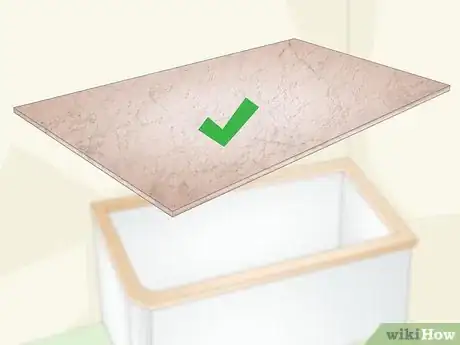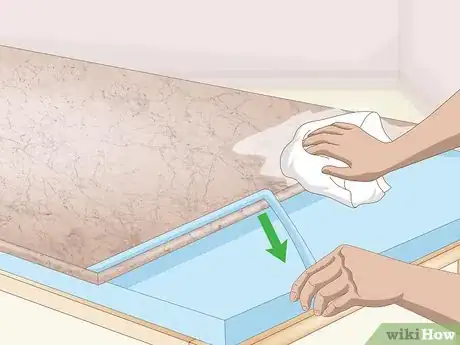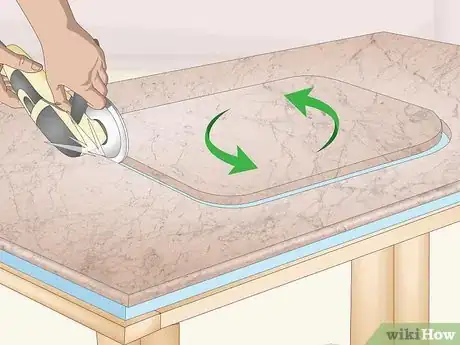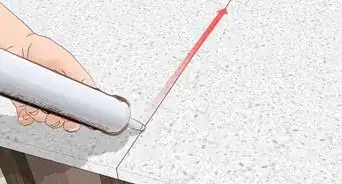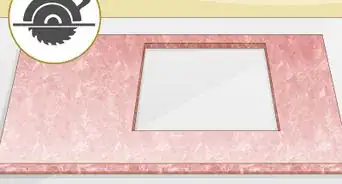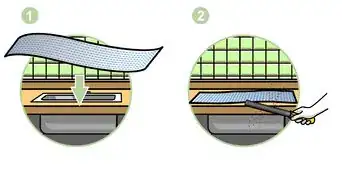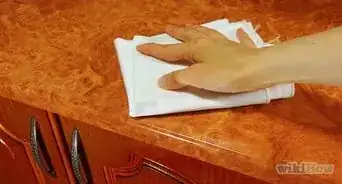This article was co-authored by Alberto DeJesus. Alberto DeJesus is a Construction Specialist and the CEO of DeJesus Industries. With more than four years of experience, he specializes in high-end real estate development and construction. Alberto and DeJesus Industries have been featured on NBC News and have worked with numerous well-known companies, including Mazda, Amazon, and CVS. Alberto holds a Bachelor’s degree from Boston University.
There are 8 references cited in this article, which can be found at the bottom of the page.
wikiHow marks an article as reader-approved once it receives enough positive feedback. In this case, several readers have written to tell us that this article was helpful to them, earning it our reader-approved status.
This article has been viewed 197,864 times.
When you want to replace or install a new countertop in your home, you may need to cut the new countertop to fit the desired area. Whether you are cutting laminate, stone, or wood countertops, you will be able to do it with a work bench and a circular saw. There are just a few different techniques you need to use depending on the material you are cutting.
Steps
Cutting Laminate or Wood Countertops
-
1Measure the area of the counter space you need to cut a top for. Measure the length and width of the space with a measuring tape. Use these numbers to determine how big of a piece of laminate countertop you need to purchase to cut to size.[1]
- Laminate countertops come in a standard width of 25 in (64 cm). You can get pieces of different lengths that you can cut down to the exact size you need.
- This method will work for cutting all types of laminate countertops, including Formica. You can also use the same method to cut solid wood countertops, such as butcher block countertops.
-
2Buy a piece of laminate countertop that will cover the counter area. Laminate countertop comes in standard sizes from 4–12 ft (1.2–3.7 m) long. They come in lengths of 2 ft (0.61 m) intervals.[2]
- Get some matching laminate strips if there will be any exposed edges of the countertop after you cut it. You can buy both the countertop and matching laminate strips at a home improvement center or kitchen showroom.
Tip: If the counter area you need to cover is divisible by exactly 2 ft (0.61 m), then you can just get a piece that fits and you won’t need to cut it to size.
Advertisement -
3Put the countertop on a workbench with the edge you will cut hanging off. Place the piece of stock laminate countertop that you purchased on a stable workbench so it won’t move while you cut it. Make sure to leave the part you will be cutting off hanging off the end of the bench.[3]
- Clamp the countertop to the workbench with C clamps to hold it in place.
-
4Place a strip of masking tape where you will cut the countertop. Use a measuring tape to measure in from the end you are going to cut off and place a strip of masking tape across the counter widthwise approximately where your cut line will be. This will keep the laminate from chipping during cutting.[4]
- You can use masking tape or blue painter’s tape that is about 2–4 in (5.1–10.2 cm) wide for this so you don’t have to be super precise when placing it.
-
5Draw your cut line onto the masking tape with a straight edge. Measure in from the end to the piece of tape and make a small mark exactly where your cut will go. Do this in 2-3 places on the tape and then draw a line through the marks with a ruler or carpenter’s square.[5]
- If you have a large carpenter’s square, you can just use that to measure in from the edge of the countertop and draw your cut line along it in one go.
-
6Secure a piece of wood to the countertop with C clamps for a saw guide. Measure the distance between the saw blade and the outside edge of the metal guard on the saw, then measure this distance in from the cut line. Clamp a piece of wood that is at least 1 in × 2 in (2.5 cm × 5.1 cm) (thickness x width) perpendicular to the cut line here so that the edge creates a guide rail.[6]
- You will need to use a circular saw for this that has a metal guard rail. If the distance between the blade of the saw and the outside edge of the guard rail is 4 in (10 cm), then clamp the wood so the edge is 4 in (10 cm) away from the cut line.
- Clamp the wood to the part of the counter that is secured to the workbench. For example, if you are cutting off the right-hand end of the countertop, then clamp the guide in from the left-hand side of the line.
-
7Set the depth of your saw blade to 1⁄8 in (0.32 cm) deeper than the countertop. Measure the thickness of the countertop in a few different places. Set the depth of the saw blade to 1⁄8 in (0.32 cm) deeper than the thickest point you found.[7]
- This will ensure the saw cuts through the whole countertop.
-
8Use your saw to cut slowly along the whole line to cut the countertop. Press down the power button of your circular saw to get the blade up to full speed first. Place the blade carefully against the start of the cut line and the outside edge of the saw guard up against the wooden guide fence. Push the saw along the line through to the end.[8]
- Always wear proper protective gear when cutting countertops. Wear safety goggles, a face mask, and ear protection.[9]
- You want to get your circular saw up to full speed before you cut so that you get a smooth cut.
- Practice cutting into the scrap piece of the countertop that you are going to cut off if you want to get a feel for cutting into the countertop with the circular saw.
-
9Sand the edge you cut to remove any rough parts or saw marks. Use fine-grit sandpaper of about 120-grit. Sand rough spots or spots with saw marks using downward strokes to avoid chipping the laminate.[10]
- Keep the masking tape on until you are done sanding. Remove the masking tape after the edge is smooth and you are happy with the results.
-
10Use a jigsaw to cut out a hole for a sink in the countertop if you need one. Trace the outline of the sink (upside down) onto the counter where you want it to go, then place masking tape and draw cut lines slightly in from the outline. Drill a pilot hole in a corner of the cut lines, insert the blade of a jigsaw, turn it on, and cut around the whole outline.[11]
- To decide how far to mark the cut lines in from the outline, measure the distance from the sink’s mounting lip to the basin of the sink. Mark the cut lines approximately this far in from the outline to allow the sink to rest on top of the counter supported by its mounting lip.
- Many sinks will also come with a template for making the perfect cutout. In this case, you can just trace the template and cut along those lines.
Cutting Stone Countertops
-
1Buy a slab of stone countertop big enough to cover the counter area. Measure the length and width of the counter area you want to cover. Order or purchase a slab of stone countertop that is approximately the right size to cover it.[12]
Tip: If you order your stone countertop from a stone supply company or specialty contractor, you can often get it cut to a custom size and delivered ready-to-install so you won’t have to do the cutting yourself.
-
2Clamp the stone slab to a workbench on top of 2 in (5.1 cm) rigid foam. Place the countertop slab on top of a piece of 2 in (5.1 cm) thick rigid foam to protect the workbench underneath it when you cut. Place a C clamp every 1–2 ft (0.30–0.61 m) along the edges to secure everything in place.[13]
- Don’t use sawhorses or any other work surface that might move while you are cutting. Stone is much heavier than other types of countertops, so you need a very stable work surface. This will also reduce vibrations and movement that can lead to chipping.
- Cutting stone is a messy business. If possible, work outside or at least in an open, well-ventilated workspace where it will be easy to clean up all the dust.
-
3Cover the section of stone you will cut with painter’s tape. Place 2-3 strips of painter’s tape over the approximate area you will be cutting. This will protect the surface of the stone and prevent chipping as you cut.[14]
- The placement of the tape doesn’t need to be perfect, just make sure you cover the area where your cut line will be. You will mark the line on top of the tape.
-
4Draw your cut line onto the painter’s tape with a straight edge and marker. Use a straight edge like a metal ruler or carpenter’s square to measure in from the end of the slab and mark where your cut line will go on the tape. Draw a cut line along the whole length of the tape using the straight edge.[15]
- Double-check your measurements to make sure the line is the same distance from the end of the slab all the way along it. You won’t be able to make any corrections to your cut after you make it, so measure twice and cut once!
-
5Make a 2 in (5.1 cm) cut in at the far end of the cut line. Carefully position the blade of a circular saw in front of the end of the cut line (where you will finish the cut). Press down the power button to get it up to speed, push it slowly in about 2 in (5.1 cm) along the line, then back it out and release the power button to stop it spinning.[16]
- This is called a back cut and is important so that the stone doesn’t chip or break at the end of your cut where it will be more fragile.
- Use a circular saw with a diamond blade for cutting stone. You can use a wet circular saw to reduce the amount of dust in the air while you cut. Make sure the depth of the saw’s blade is set to just a bit deeper than the thickness of the stone slab.
- Make sure to put on safety goggles, a dust mask, and ear protection before you start cutting.[17]
-
6Position the saw at the other end of the cut line and cut slowly along it. Walk back over to the other side of the cut line with your saw and carefully line up the blade with the cut line. Press the power button to get the blade up to speed, then slowly push the saw all the way along the cut line until you meet the back cut.[18]
- Focus on keeping the saw blade aligned with the cut line and push very slowly. The blade will do most of the work, so you just need to apply light and steady pressure to push it along slowly.
- Cutting stone takes longer than cutting other materials like laminate or wood, so be patient and focus on making a straight cut.
-
7Remove the tape and wipe the stone countertop with a damp rag. Peel off the tape once you finish cutting all the way through. Wipe away all the dust with a wet rag and you will be left with a clean new stone countertop![19]
- A shop vac will also come in handy for sucking up all the rock dust that is left after cutting the stone countertop.
-
8Use an angle grinder with a diamond blade to make a sink cut out if needed. Buy a sink that comes with a template for the cutout and trace the template onto masking tape on the countertop. Cut 1-2 mm inside of the lines with the angle grinder and work in passes until you cut all the way through the slab along the lines.[20]
- You can work in sections if it is easier. For example, cut out a large rectangular middle section first, then cut out the sides. Leave rounded corners for last so you can cut them out in smaller pieces.
Expert Q&A
-
QuestionHow can I cut my stone countertop without chipping?
 Alberto DeJesusAlberto DeJesus is a Construction Specialist and the CEO of DeJesus Industries. With more than four years of experience, he specializes in high-end real estate development and construction. Alberto and DeJesus Industries have been featured on NBC News and have worked with numerous well-known companies, including Mazda, Amazon, and CVS. Alberto holds a Bachelor’s degree from Boston University.
Alberto DeJesusAlberto DeJesus is a Construction Specialist and the CEO of DeJesus Industries. With more than four years of experience, he specializes in high-end real estate development and construction. Alberto and DeJesus Industries have been featured on NBC News and have worked with numerous well-known companies, including Mazda, Amazon, and CVS. Alberto holds a Bachelor’s degree from Boston University.
Construction Specialist Make sure that you're using a blade designed to cut countertop! By using the wrong blade, you risk damaging your beautiful stone.
Make sure that you're using a blade designed to cut countertop! By using the wrong blade, you risk damaging your beautiful stone. -
QuestionWhat kind of saw blade do I need to use?
 Robert MayewCommunity AnswerIt depends on what material you're cutting.
Robert MayewCommunity AnswerIt depends on what material you're cutting.
Warnings
- Wear eye, face, and ear protection whenever you are cutting countertops and operating power tools.[21]⧼thumbs_response⧽
Things You’ll Need
Cutting Laminate Countertops
- Laminate countertop
- Workbench
- Masking tape
- Measuring tape
- Circular saw
- Pencil or pen
- Fine-grit sandpaper
- 1 in × 2 in (2.5 cm × 5.1 cm) wood
- Ruler or carpenter’s square
- C clamps
- Jigsaw (optional)
Cutting Stone Countertops
- Stone countertop
- Circular saw with diamond blade
- Workbench
- 2 in (5.1 cm) thick rigid foam
- Painter’s tape
- C clamps
- Straight edge
- Marker
- Damp rag
- Angle grinder with diamond blade (optional)
References
- ↑ https://www.familyhandyman.com/kitchen/countertops/install-a-laminate-kitchen-countertop/
- ↑ https://diyhousetips.com/193/how-to-cut-a-laminate-countertop/
- ↑ https://diyhousetips.com/193/how-to-cut-a-laminate-countertop/
- ↑ https://diyhousetips.com/193/how-to-cut-a-laminate-countertop/
- ↑ https://www.thesawguy.com/how-to-cut-laminate-countertop/
- ↑ https://diyhousetips.com/193/how-to-cut-a-laminate-countertop/
- ↑ https://diyhousetips.com/193/how-to-cut-a-laminate-countertop/
- ↑ https://diyhousetips.com/193/how-to-cut-a-laminate-countertop/
- ↑ Alberto DeJesus. Construction Specialist. Expert Interview. 15 December 2021.
- ↑ https://diyhousetips.com/193/how-to-cut-a-laminate-countertop/
- ↑ https://www.finehomebuilding.com/2014/02/21/how-to-cut-an-opening-for-a-sink-in-a-laminate-counter-top
- ↑ https://www.familyhandyman.com/kitchen/countertops/how-to-cut-marble/
- ↑ https://www.familyhandyman.com/kitchen/countertops/how-to-cut-marble/
- ↑ https://www.bobvila.com/articles/how-to-cut-granite/
- ↑ https://www.bobvila.com/articles/how-to-cut-granite/
- ↑ https://www.bobvila.com/articles/how-to-cut-granite/
- ↑ Alberto DeJesus. Construction Specialist. Expert Interview. 15 December 2021.
- ↑ https://www.bobvila.com/articles/how-to-cut-granite/
- ↑ https://www.bobvila.com/articles/how-to-cut-granite/
- ↑ https://www.youtube.com/watch?v=MUh0fQnWkV4&feature=youtu.be&t=24
- ↑ Alberto DeJesus. Construction Specialist. Expert Interview. 15 December 2021.
About This Article
Cutting a countertop is relatively simple, but there are certain steps you’ll need to take to avoid damaging it. Lay a strip of masking tape where you want to cut the countertop and draw your cut line on it with a pencil and ruler. If your countertop is laminate or wood, secure a piece of wood to the end with C-clamps for a saw guide. If it’s made of stone, clamp it to your workbench on top of a layer of rigid foam. You should also make a 2-inch cut at the far end of your stone countertop so the off-cut will fall off cleanly instead of splintering. Use a circular saw with a blade 1/8-inch deeper than your countertop to ensure it cuts through. Make sure your blade’s up to full speed before you start cutting and move the blade slowly.Once you've finished, sand the cut edge of your surface with fine-grit sandpaper to make it nice and smooth. For more tips, including how to cut a sink hole in your countertop, read on!
